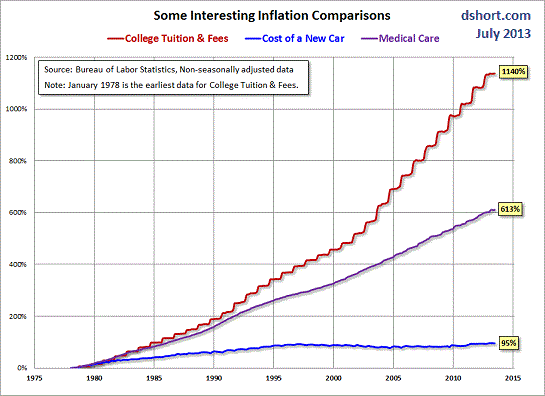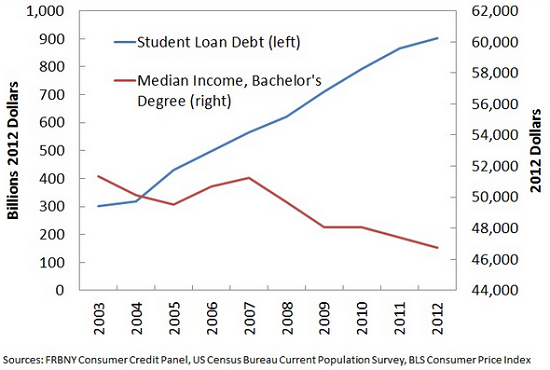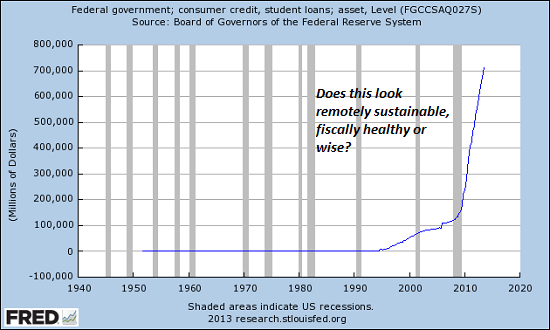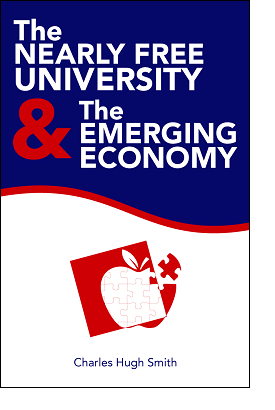Higher Education: America's Problem That Isn't Being Solved
Once we accredit the student, not the institution, existing universities will compete directly with Nearly Free Universities not in issuing diplomas but in how much students actually learned and mastered.
One of the key insights from recent work in psychology is that humans tend to substitute easier problems rather than solve difficult problems. Daniel Kahneman explained this dynamic in his recent book Thinking, Fast and Slow.
To "solve" a difficult problem we are unfamiliar with, we substitute a lesser problem we already know the answer to, and then declare we've "solved" the original (often knotty, complex) problem.
The real problem then festers, unsolved and addressed, while the misguided "solution" only drains resources and exacerbates the real problem.
An excellent example of this dynamic is higher education: the real problems are soaring costs and sharply declining yields in actual learning and in the real-world value of a diploma.
Consider the study Academically Adrift: Limited Learning on College Campuses which concluded that "American higher education is characterized by limited or no learning for a large proportion of students."
These charts illustrate the costs and diminishing returns:

The yield (in earnings) on the increasingly unaffordable college degree is declining sharply:

The Status Quo has substituted two false "solutions" that completely ignore the real problems of soaring costs and diminishing returns: increasing student loans and hiring hundreds of thousands of non-teaching administrators.
While student loans have soared to over $1 trillion, with direct Federal loans ballooning from $115 billion to over $700 billion in a few short years, only 37% of freshmen at four-year colleges graduate in four years (58% finally graduate in six years), and 53% of recent college graduates under the age of 25 are unemployed or doing work they could have done without going to college.

New Analysis Shows Problematic Boom In Higher Ed Administrators:
In all, from 1987 until 2011-12--the most recent academic year for which comparable figures are available—universities and colleges collectively added 517,636 administrators and professional employees, according to the analysis by the New England Center for Investigative Reporting.
“There’s just a mind-boggling amount of money per student that’s being spent on administration,” said Andrew Gillen, a senior researcher at the institutes. “It raises a question of priorities.”
The ratio of nonacademic employees to faculty has also doubled. There are now two nonacademic employees at public and two and a half at private universities and colleges for every one full-time, tenure-track member of the faculty.
The number of employees in central system offices has increased six-fold since 1987, and the number of administrators in them by a factor of more than 34.I have demonstrated in my book The Nearly Free University and The Emerging Economy: The Revolution in Higher Education that the tuition for a four-year bachelor's degree could (and should) cost $5,000, not $100,000 or $200,000.
The technology and tools already exist to accredit the student, not the institution and provide distributed courses, adaptive learning and real-world, workplace-based workshops for a tiny fraction of the ineffective, unaffordable system of higher education we are currently burdened with.
Once costs decline 95%, there is no need for student loans or the bloated bureaucracies currently overseeing the parasitic student-loan system.
Once we accredit the student, not the institution, existing universities will compete directly with Nearly Free Universities not in issuing diplomas but in how much students actually learned and mastered. If students can learn as much or more for $5,000 (including workshops in real-world workplaces) than they do for $160,000 in conventional universities, then the sectors of higher education that charge $160,000 for a 4-year degree will vanish.
In essence, technology has leapfrogged the existing higher education Status Quo, just as it has leapfrogged the banking sector.
Gordon T. Long and I discuss these issues in this 25-minute program:
YouTube link to the program
Here is a taste of what we discuss:
THE LEGACY SYSTEM IS OBSOLETE
THE FUNDAMENTALS HAVE CHANGED
The Nearly Free University and The Emerging Economy:
The Revolution in Higher Education
Reconnecting higher education, livelihoods and the economyWith the soaring cost of higher education, has the value a college degree been turned upside down? College tuition and fees are up 1000% since 1980. Half of all recent college graduates are jobless or underemployed, revealing a deep disconnect between higher education and the job market.
It is no surprise everyone is asking: Where is the return on investment? Is the assumption that higher education returns greater prosperity no longer true? And if this is the case, how does this impact you, your children and grandchildren?

We must thoroughly understand the twin revolutions now fundamentally changing our world: The true cost of higher education and an economy that seems to re-shape itself minute to minute.
The Nearly Free University and the Emerging Economy clearly describes the underlying dynamics at work - and, more importantly, lays out a new low-cost model for higher education: how digital technology is enabling a revolution in higher education that dramatically lowers costs while expanding the opportunities for students of all ages.
The Nearly Free University and the Emerging Economy provides clarity and optimism in a period of the greatest change our educational systems and society have seen, and offers everyone the tools needed to prosper in the Emerging Economy.
Read Chapter 1/Table of Contents
print ($20) Kindle ($9.95)
Things are falling apart--that is obvious. But why are they falling apart? The reasons are complex and global. Our economy and society have structural problems that cannot be solved by adding debt to debt. We are becoming poorer, not just from financial over-reach, but from fundamental forces that are not easy to identify. We will cover the five core reasons why things are falling apart:
 1. Debt and financialization
1. Debt and financialization2. Crony capitalism
3. Diminishing returns
4. Centralization
5. Technological, financial and demographic changes in our economy
Complex systems weakened by diminishing returns collapse under their own weight and are replaced by systems that are simpler, faster and affordable. If we cling to the old ways, our system will disintegrate. If we want sustainable prosperity rather than collapse, we must embrace a new model that is Decentralized, Adaptive, Transparent and Accountable (DATA).
We are not powerless. Once we accept responsibility, we become powerful.
Read the Introduction/Table of ContentsKindle: $9.95 print: $24
| Thank you, Susannah W. ($100), for your outrageously generous contribution to this site -- I am greatly honored by your steadfast support and readership. | Thank you, Duane S. ($20), for your much-appreciated generous contribution to this site -- I am greatly honored by your support and readership. |



























